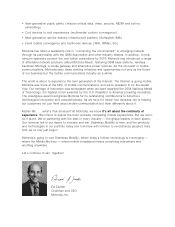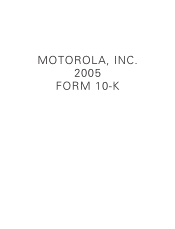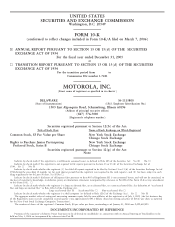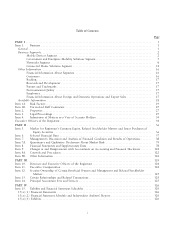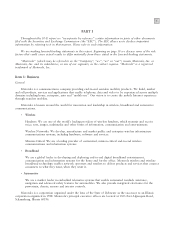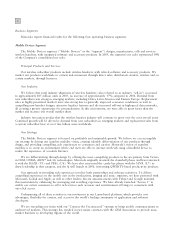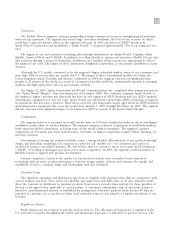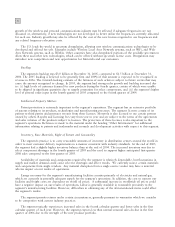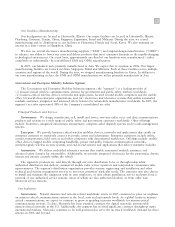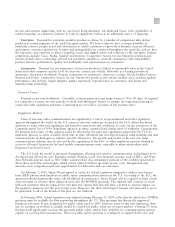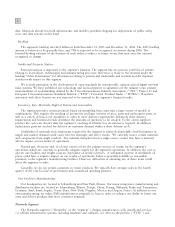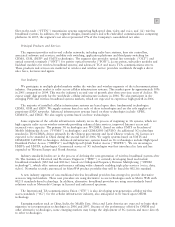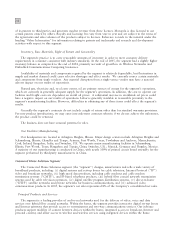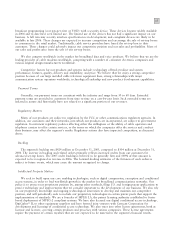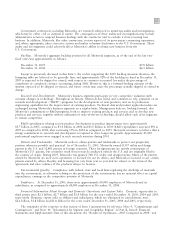Motorola 2005 Annual Report Download - page 14
Download and view the complete annual report
Please find page 14 of the 2005 Motorola annual report below. You can navigate through the pages in the report by either clicking on the pages listed below, or by using the keyword search tool below to find specific information within the annual report.
7
services and systems engineering, with no one factor being dominant. An additional factor is the availability of
vendor financing, as customers continue to look to equipment vendors as an additional source of financing.
Enterprise: Demand for enterprise mobility products is driven by a number of competitors who deliver
products in certain segments of the total Enterprise market. We believe that we have a unique portfolio to
seamlessly connect people, assets and information to enable customers to grow their business, increase efficiency
and improve customer satisfaction. Security and manageability are common throughout our portfolio, and we have
the experience and expertise to deliver seamless, secure and rugged end-to-end solutions to the enterprise. Primary
competitors include: Cisco, Nokia, Symbol and Intermec. Competitive factors for our Enterprise products and
systems include: price; technology offered and standards compliance; network convergence and compatibility;
product features, performance, quality and availability; and responsiveness to customers.
Automotive: Demand for our automotive electronics products is linked to automobile sales in the United
States and other countries and the level of electronic content per vehicle. Motorola is a leading provider of
automotive electronics worldwide. Primary competitors in automotive electronics include: Bosch, Delphi, Visteon,
Siemens and Denso. Competitive factors for our Automotive products and systems include: price; product quality;
performance and delivery; supply integrity; quality reputation; responsiveness to customers; and design and
manufacturing technology.
Payment Terms
Payment terms vary worldwide. Generally, contract payment terms range from net 30 to 60 days. As required
for competitive reasons, we may provide or work with third-party lenders to arrange for long-term financing in
connection with equipment purchases. Financing may cover all or a portion of the purchase price.
Regulatory Matters
Users of two-way radio communications are regulated by a variety of governmental and other regulatory
agencies throughout the world. In the U.S., users of two-way radios are licensed by the FCC, which has broad
authority to make rules and regulations and prescribe restrictions and conditions to carry out the provisions of the
Communications Act of 1934. Regulatory agencies in other countries have similar types of authority. Consequently,
the business and results of this segment could be affected by the rules and regulations adopted by the FCC or
regulatory agencies in other countries from time to time. Motorola has developed products using trunking and data
communications technologies to enhance spectral efficiencies. The growth and results of the two-way radio
communications industry may be affected by the regulations of the FCC or other regulatory agencies relating to
access to allocated frequencies for land mobile communications users, especially in urban areas where such
frequencies are heavily used.
The U.S. leads the world in spectrum deregulation, allowing new wireless communications technologies to be
developed and offered for sale. Examples include Wireless Local Area Network systems, such as WiFi, and Wide
Area Network systems, such as Wi4. Other countries have also deregulated portions of the available spectrum to
allow these and other technologies, which can be offered without spectrum license costs. Deregulation may
introduce new competition and new opportunities for Motorola and our customers.
On February 7, 2005, Sprint Nextel agreed to a plan by federal regulators designed to address interference
from iDEN phones with hundreds of public safety communications systems in the U.S. According to the FCC, the
agreement should dramatically reduce the likelihood of interference. Sprint Nextel will be required to fund certain
costs necessary to relocate those impacted users into the 800MHz spectrum. The segment will continue to work
with our customers that are impacted by this plan and expects that this will have a neutral to positive impact on
the segment's business over the next several years. However, the short-term impact remains uncertain and is yet to
be quantified, as all of the details of the plan are not finalized.
In February 2006, federal legislation was adopted setting February 17, 2009 as the date by which key 700MHz
spectrum must be available for first responders throughout the U.S. This spectrum has historically supported
broadcast television. It was designated for public safety back in 1997, however, prior to this new legislation, there
was no certainty as to when it actually would be cleared for public safety use in major markets. Clearing TV from
this band will significantly increase the spectrum public safety entities have available for communications systems
capable of covering their jurisdictions. This new public safety spectrum is configured to support both voice and


